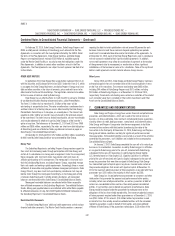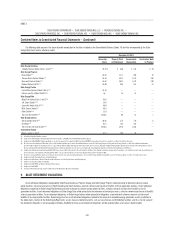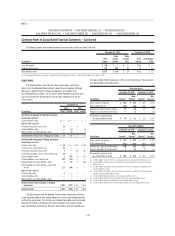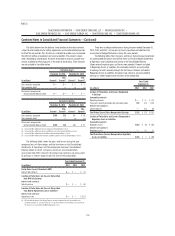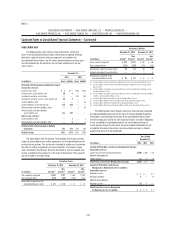Duke Energy 2014 Annual Report Download - page 172
Download and view the complete annual report
Please find page 172 of the 2014 Duke Energy annual report below. You can navigate through the pages in the report by either clicking on the pages listed below, or by using the keyword search tool below to find specific information within the annual report.
152
PART II
DUKE ENERGY CORPORATION • DUKE ENERGY CAROLINAS, LLC • PROGRESS ENERGY, INC. •
DUKE ENERGY PROGRESS, INC. • DUKE ENERGY FLORIDA, INC. • DUKE ENERGY OHIO, INC. • DUKE ENERGY INDIANA, INC.
Combined Notes to Consolidated Financial Statements – (Continued)
to refl ect appropriate debt and equity ratios for its regulated operations. The
restructuring was completed in the second quarter of 2014, and resulted in the
transfer of all of Duke Energy Ohio’s nonregulated generation assets, excluding
Beckjord, out of its regulated public utility subsidiary and into DECAM.
14. DERIVATIVES AND HEDGING
The Duke Energy Registrants use commodity and interest rate contracts
to manage commodity price and interest rate risks. The primary use of energy
commodity derivatives is to hedge the generation portfolio against changes in
the prices of electricity and natural gas. Interest rate swaps are used to manage
interest rate risk associated with borrowings.
All derivative instruments not identifi ed as NPNS are recorded at fair value
as assets or liabilities on the Consolidated Balance Sheets. Cash collateral
related to derivative instruments executed under master netting agreement is
offset against the collateralized derivatives on the balance sheet.
Changes in the fair value of derivative agreements that either do not
qualify for or have not been designated as hedges are refl ected in current
earnings or as regulatory assets or liabilities.
COMMODITY PRICE RISK
The Duke Energy Registrants are exposed to the impact of changes in the
future prices of electricity, coal and natural gas. Exposure to commodity price
risk is infl uenced by a number of factors including the term of contracts, the
liquidity of markets, and delivery locations.
Fair Value and Cash Flow Hedges
At December 31, 2014, there were no open commodity derivative
instruments designated as hedges.
Undesignated Contracts
Undesignated contracts may include contracts not designated as a hedge,
contracts that do not qualify for hedge accounting, derivatives that do not or
no longer qualify for the NPNS scope exception, and de-designated hedge
contracts. These contracts expire as late as 2018.
Duke Energy Carolinas’ undesignated contracts are primarily associated
with forward sales and purchases of electricity. Duke Energy Progress’ and
Duke Energy Florida’s undesignated contracts are primarily associated with
forward purchases of natural gas. Duke Energy Ohio’s undesignated contracts
are primarily associated with forward sales and purchases of electricity, coal
and natural gas. Duke Energy Indiana’s undesignated contracts are primarily
associated with forward purchases and sales of electricity and fi nancial
transmission rights.
Volumes
The tables below show information relating to volumes of outstanding
commodity derivatives. Amounts disclosed represent the notional volumes of
commodity contracts excluding NPNS. Amounts disclosed represent the absolute
value of notional amounts. The Duke Energy Registrants have netted contractual
amounts where offsetting purchase and sale contracts exist with identical delivery
locations and times of delivery. Where all commodity positions are perfectly offset,
no quantities are shown.
December 31, 2014
Duke
Energy
Duke Energy
Carolinas
Progress
Energy
Duke Energy
Progress
Duke Energy
Florida
Duke Energy
Ohio
Duke Energy
Indiana
Electricity (gigawatt-hours)(a) 25,370 — — — — 19,141 —
Natural gas (millions of decatherms) 676 35 328 116 212 313 —
December 31, 2013
Duke
Energy
Duke Energy
Carolinas
Progress
Energy
Duke Energy
Progress
Duke Energy
Florida
Duke Energy
Ohio
Duke Energy
Indiana
Electricity (gigawatt-hours)(a) 71,466 1,205 925 925 — 69,362 203
Natural gas (millions of decatherms) 636 — 363 141 222 274 —
(a) Amounts at Duke Energy Ohio include intercompany positions that eliminate at Duke Energy.
INTEREST RATE RISK
The Duke Energy Registrants are exposed to changes in interest rates as
a result of their issuance or anticipated issuance of variable-rate and fi xed-rate
debt and commercial paper. Interest rate risk is managed by limiting variable-
rate exposures to a percentage of total debt and by monitoring changes in
interest rates. To manage risk associated with changes in interest rates, the
Duke Energy Registrants may enter into interest rate swaps, U.S. Treasury lock
agreements, and other fi nancial contracts. In anticipation of certain fi xed-rate
debt issuances, a series of forward starting interest rate swaps may be executed
to lock in components of current market interest rates. These instruments are
later terminated prior to or upon the issuance of the corresponding debt. Pretax
gains or losses recognized from inception to termination of the hedges are
amortized as a component of interest expense over the life of the debt.
Duke Energy has a combination foreign exchange, pay fi xed-receive
fl oating interest rate swap to fi x the U.S. dollar equivalent payments on a
fl oating-rate Chilean debt issue.


